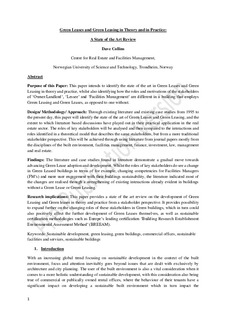| dc.description.abstract | Purpose – This paper aims to identify the state of the art in Green Leases and Green Leasing in theory and practice, while also identifying how the roles and motivations of the stakeholders of “owner/landlord”, “lessee” and “facilities management” are different in a building that uses Green Leasing and Green Leases, as opposed to the one without. Design/methodology/approach – Through existing literature and existing case studies from 1995 to the present day, this paper will identify the state of the art of Green Leases and Green Leasing and the extent to which literature-based discussions have played out in their practical application in the real estate sector. The roles of key stakeholders will be analysed and then compared to the interactions and roles identified in a theoretical model that describes the same stakeholders but from a more traditional stakeholder perspective. This will be achieved through using literature from journal papers mostly from the disciplines of built environment, facilities management, finance, investment, law, management and real estate. Findings – The literature and case studies found in literature demonstrate a gradual move towards advancing Green Lease adoption and development. While the roles of key stakeholders do see a change in Green Leased buildings in terms of, for example, changing competencies for facilities managers (FMs) and more user engagement with their buildings sustainability, the literature indicated most of the changes are realised through a strengthening of existing interactions already evident in buildings without a Green Lease or Green Leasing. Originality/value – This paper provides a state of the art review on the development of Green Leasing and Green Leases in theory and practice from a stakeholder perspective. It provides possibility to expand further on the changing roles of these stakeholders in Green buildings, which in turn could also positively affect the further development of Green Leases themselves, as well as sustainable certification methodologies such as Europe’s leading certification “Building Research Establishment Environmental Assessment Method” (BREEAM). Keywords Sustainable development, Green leasing, Sustainable buildings, Green buildings, Commercial offices, Sustainable facilities and services Paper type Literature review | nb_NO |
